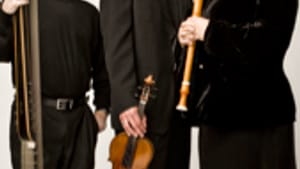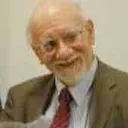Stay in the Loop
BSR publishes on a weekly schedule, with an email newsletter every Wednesday and Thursday morning. There’s no paywall, and subscribing is always free.
Bach resuscitated (with a little help from the Jews of Berlin)
Tempesta di Mare recreates Madame Levy's Salon

The first half of Tempesta di Mare's latest offering was a good example of the conflict between art and entertainment. The three pieces were all worth hearing and included one authentic masterpiece, but none of them would have won any prizes for foot-tapping liveliness. The program would have worked better, as a program, if one of the entries had been replaced with something that moved at a faster pace.
Still, all were works that repaid close listening. The "modern world premiere" that opened the program was a graceful sonata for flute and two violins by Johan Janitsch, and W.F. Bach's sonata for two violins was another graceful piece. The acknowledged masterpiece was the Sonata on the Royal Theme from the "Musical Offering" that W.F. Bach's father presented to Frederick the Great. Bach responded to Frederick's theme with a set of 13 pieces, thus proving that a genius can turn the most unpromising material into music people will listen to centuries after it's written. The allegro contains flashes of Bachian bounciness, but overall the great trio sonata is a piece you listen to for its musical complexity.
The program livened up after the intermission. The C.P.E. Bach quartet that opened the second half contained one of the few genuinely funny musical jokes I've heard. The harpsichordist kept stopping at odd places, as if he'd lost his place or just felt contrary, and held the pause until you were just about convinced the quartet had reached an abrupt finish. It may sound like a childish bit of fooling, but it drew a laugh every time.
A woman who liked a challenge
C.P.E.'s composition was billed as a quartet, but it only required three instruments— the harpsichord, a flute and a viola. The harpsichordist played two of the parts, one with each hand. The Tempesta program presented music played at the salon hosted by Mendelssohn's great-aunt in late-18th-Century Berlin, and Sara Levy seems to have been an amateur harpsichordist who liked to rise to a challenge.
The last piece on the program stemmed from the brain of Johann Quantz, a master flutist whose book, On Playing the Flute, is one of the standard sources on Baroque performance practice. I've heard some of the pieces Quantz wrote for Frederick the Great after he joined Frederick's court, and the flute parts suggest that Quantz knew his patron's limits. Frederick seems to have been a respectable, dedicated amateur composer, but obviously he had to devote most of his attention to his career as a military genius and enlightened despot.
Quantz's Quartet in E Minor was composed before he joined Frederick, when he worked for the Elector of Dresden. The flute part was obviously written by a composer who understood the flute and its potential, and knew the flute line would be executed by one of the best flutists in Europe. The whole piece brought the afternoon to a good close, but Gwyn Roberts's wooden Baroque flute sounded particularly brilliant.
A flair for program notes
When I get around to establishing my annual prize for program notes, Tempesta di Mare's directors will be prime contenders. Several younger musicians aren't afraid to write with a little flair, but Gwyn Roberts and Richard Stone deserve special mention for their description of the Musical Offering as "the mother of all comebacks." I also liked their suggestion that the difficulties of the flute part in the trio sonata included a touch of "Take that, you flute player king." You can write quips like that only if you really know your subject.
This is the second time the Tempesta crew has visited Madame Levy's salon, and their summary of its history connected some interesting dots. Madame Levy's salon flourished in the late 18th and early 19th Century, but she preferred the serious music of an earlier period. Madame Levy was one of the people who kept Bach's music alive during the period in which it was generally neglected. Her grandnephew, Felix Mendelssohn, launched the Bach revival by conducting the St. Matthew Passion from a score he received from his grandmother, Sara Levy's sister.
Bach is sometimes referred to as "the fifth apostle" because of the power of his masses and passions. But he owes some of his present eminence to the musical acumen of several leading figures in the Jewish community of Berlin.
Still, all were works that repaid close listening. The "modern world premiere" that opened the program was a graceful sonata for flute and two violins by Johan Janitsch, and W.F. Bach's sonata for two violins was another graceful piece. The acknowledged masterpiece was the Sonata on the Royal Theme from the "Musical Offering" that W.F. Bach's father presented to Frederick the Great. Bach responded to Frederick's theme with a set of 13 pieces, thus proving that a genius can turn the most unpromising material into music people will listen to centuries after it's written. The allegro contains flashes of Bachian bounciness, but overall the great trio sonata is a piece you listen to for its musical complexity.
The program livened up after the intermission. The C.P.E. Bach quartet that opened the second half contained one of the few genuinely funny musical jokes I've heard. The harpsichordist kept stopping at odd places, as if he'd lost his place or just felt contrary, and held the pause until you were just about convinced the quartet had reached an abrupt finish. It may sound like a childish bit of fooling, but it drew a laugh every time.
A woman who liked a challenge
C.P.E.'s composition was billed as a quartet, but it only required three instruments— the harpsichord, a flute and a viola. The harpsichordist played two of the parts, one with each hand. The Tempesta program presented music played at the salon hosted by Mendelssohn's great-aunt in late-18th-Century Berlin, and Sara Levy seems to have been an amateur harpsichordist who liked to rise to a challenge.
The last piece on the program stemmed from the brain of Johann Quantz, a master flutist whose book, On Playing the Flute, is one of the standard sources on Baroque performance practice. I've heard some of the pieces Quantz wrote for Frederick the Great after he joined Frederick's court, and the flute parts suggest that Quantz knew his patron's limits. Frederick seems to have been a respectable, dedicated amateur composer, but obviously he had to devote most of his attention to his career as a military genius and enlightened despot.
Quantz's Quartet in E Minor was composed before he joined Frederick, when he worked for the Elector of Dresden. The flute part was obviously written by a composer who understood the flute and its potential, and knew the flute line would be executed by one of the best flutists in Europe. The whole piece brought the afternoon to a good close, but Gwyn Roberts's wooden Baroque flute sounded particularly brilliant.
A flair for program notes
When I get around to establishing my annual prize for program notes, Tempesta di Mare's directors will be prime contenders. Several younger musicians aren't afraid to write with a little flair, but Gwyn Roberts and Richard Stone deserve special mention for their description of the Musical Offering as "the mother of all comebacks." I also liked their suggestion that the difficulties of the flute part in the trio sonata included a touch of "Take that, you flute player king." You can write quips like that only if you really know your subject.
This is the second time the Tempesta crew has visited Madame Levy's salon, and their summary of its history connected some interesting dots. Madame Levy's salon flourished in the late 18th and early 19th Century, but she preferred the serious music of an earlier period. Madame Levy was one of the people who kept Bach's music alive during the period in which it was generally neglected. Her grandnephew, Felix Mendelssohn, launched the Bach revival by conducting the St. Matthew Passion from a score he received from his grandmother, Sara Levy's sister.
Bach is sometimes referred to as "the fifth apostle" because of the power of his masses and passions. But he owes some of his present eminence to the musical acumen of several leading figures in the Jewish community of Berlin.
What, When, Where
Tempesta di Mare: Janitsch, Sonata di Camera in C; J.S. Bach, Sonata sopr’il Soggetto Reale in C Minor; W.F. Bach, Sonata in B-flat; C.P.E. Bach, Quartet in D Major; Quantz, Quartet in E Minor. Gwyn Roberts, flute; Emlyn Ngai, violin; Karina Fox, violin and viola; Eve Miller, cello; Richard Stone, lute; Adam Pearl, harpsichord. March 22, 2009 at Old St. Joseph’s Church, 321 Willings Alley. (215) 755-8776 or www.tempestadimare.org.
Sign up for our newsletter
All of the week's new articles, all in one place. Sign up for the free weekly BSR newsletters, and don't miss a conversation.
 Tom Purdom
Tom Purdom